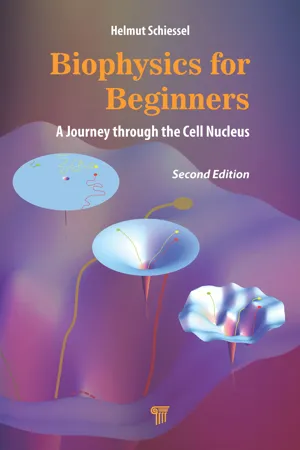Chemistry
Chargaffs Rule
Chargaff's Rule states that in DNA, the amount of adenine (A) is equal to the amount of thymine (T), and the amount of guanine (G) is equal to the amount of cytosine (C). This rule is important in understanding the structure and function of DNA, as it provides insight into the complementary base pairing that occurs in the DNA double helix.
Written by Perlego with AI-assistance
3 Key excerpts on "Chargaffs Rule"
- eBook - ePub
- David P. Clark(Author)
- 2009(Publication Date)
- Academic Cell(Publisher)
base pairs involves either oxygen or nitrogen as the atoms that carry the hydrogen, giving three alternative arrangements: O–H–O, N–H–N and O–H–N.Figure 3.09 Double Helix—50th Anniversary Coin A £2 coin commemorating the discovery of the double helix was issued in 2003 by Great Britain.Figure 3.10 Base Pairing by Hydrogen Bond Formation Purines (adenine and guanine) pair with pyrimidines (thymine and cytosine) by hydrogen bonding (colored regions). When the purines and pyrimidines first come together, they form the bonds indicated by the dotted lines.antiparallel Parallel, but running in opposite directions base pair Two bases held together by hydrogen bonds double helix Structure formed by twisting two strands of DNA spirally around each other hydrogen bond Bond resulting from the attraction of a positive hydrogen atom to both of two other atoms with negative charges right-handed helix In a right-handed helix, as the observer looks down the helix axis (in either direction), each strand turns clockwise as it moves away from the observer Working in Cambridge, England, James Watson and Francis Crick based their model of the double helix partly on the interpretation of data from X-ray crystallography by Rosalind Franklin and Maurice Wilkins, which suggested a helical molecule. Chemical analysis by Erwin Chargaff showed that DNA contained equimolar amounts of A and T and also of G and C. This, and chemical modeling, led Watson and Crick to propose that DNA was double stranded and that A in one strand is always paired with T in the other. Similarly, G is always paired with C. Watson and Crick published their landmark paper in Nature (Fig. 3.08 - eBook - ePub
The Path to the Double Helix
The Discovery of DNA
- Robert Olby(Author)
- 2013(Publication Date)
- Dover Publications(Publisher)
Fig. 21.7 ). All the hydrogen bonds seemed to form naturally; no fudging was required to make the two types of base pairs identical in shape. Quickly I called Jerry over to ask him whether this time he had any objection to my new base pairs.When he said no, my morale skyrocketed, for 1 suspected that we now had the answer to the riddle of why the number of purine residues exactly equalled the number of pyrimidine residues. Two irregular sequences of bases could be regularly packed in the centre of a helix if a purine was always hydrogen-bonded to a pyrimidine. Furthermore, the hydrogen-bonding requirement meant that adenine would always pair with thymine, while guanine could pair only with cytosine. Chargaff’s rules then suddenly stood out as a consequence of a double-helical structure for DNA. Even more exciting, this type of double helix suggested a replication scheme much more satisfactory than my briefly considered like-with-like pairing. Always pairing adenine with thymine and guanine with cytosine meant that the base sequences of the two intertwined chains were complementary to each other. Given the base sequence of one chain, that of its partner was automatically determined. Conceptually, it was thus very easy to visualize how a single chain could be the template for the synthesis of a chain with the complementary sequence.(Helix , 195–196)When Crick came in, the characteristic scepticism of the collaborator was quickly dispelled. The similar shape of the two base pairs was compelling. But was there another way of pairing the bases so as to give the Chargaff ratios? Shifting the bases into other positions did not reveal one. Then he was struck by the symmetry of the glycosidic bonds which joined the bases to the respective backbones. They were related by a diad axis in the plane of the base pairs, which could be rotated through 180° to give the same orientation of these bonds. Knowing from that MRC report that crystalline DNA had C2 symmetry again proved crucial “because as soon as I saw Watson’s base pairing I said: “Look, it’s got the right symmetry” (Crick, 1968/72). This, together with the density, dominant features of the B diffraction pattern, and Chargaff s ratios could all be accounted for by their model. In principle, the biological functions of encoding genetic information, replicating and expressing it, could also be envisaged. This was no false trail. This was not a case of anti-climax in which a boring structure was emerging with no suggestions for biology. It was just so good it had got to be true! - eBook - ePub
Biophysics for Beginners
A Journey through the Cell Nucleus
- Helmut Schiessel(Author)
- 2021(Publication Date)
- Jenny Stanford Publishing(Publisher)
Fig. 4.4 . Both are purine-pyrimidine pairs and therefore the resulting two structures are approximately the same size. The specific base pairing explained the mysterious Chargaff’s rules: For any given DNA sample, the amount of A equals the amount of T and the amount of C equals the amount of G.Figure 4.4Once the base pairing was found, the road was paved for 1953’s great discovery byWatson and Crick: the DNA double helix.It was then quite straightforward for Watson and Crick to build a ball-stick model of a double helix with the base pairs forming a regular stack in the middle and the backbones facing the water at the outside (see Fig. 4.4 ). The model was published in 1953 in the journal Nature (Watson and Crick, 1953 ). Watson and Crick did not speak about biological implications, except in the last sentence: “It has not escaped our notice that the specific pairing we have postulated immediately suggests a possible copying mechanism for the genetic material.”4.2 DNA on the Base Pair LevelIn the previous section we presented the general ideas that led to the discovery of the DNA double helix. In this section we provide a more detailed discussion of possible helix geometries. As we shall see, there are various possibilities. We also discuss how the underlying base pair sequence affects the mechanical properties of such helices. In the first subsection we present a geometric picture which provides useful insights into the structure and mechanical properties of the DNA double helix. However, the approach has its limits: Even though there is nothing wrong with it, some of the experimental observations, e.g., the sequence preferences of nucleosomes which contain strongly bent DNA, go against our intuition. This requires a quantitative approach which is described in the second subsection.
Index pages curate the most relevant extracts from our library of academic textbooks. They’ve been created using an in-house natural language model (NLM), each adding context and meaning to key research topics.
Explore more topic indexes
Explore more topic indexes
1 of 6
Explore more topic indexes
1 of 4


